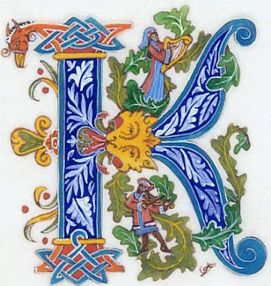Glossary
of Pysanka-Related Terms
Glossary
of Pysanka-Related Terms

K
Katerynoslav (Катеринослав): the old name for Dnipropetrovsk, which has since been renamed simply “Dnipro.”
Kholm (Холм): western Ukrainian city and region, now in Poland. The Ukrainian inhabitants of Kholm were resettled throughout Ukraine and western Poland in the post-WWII period.
kistka (кістка): another term for a pysachok/stylus, commonly used in the diaspora and among non-Ukrainians. This was probably a localized Ukrainian usage; it has become commonly used in North America, in part due to its usage by the Ukrainian Gift Shop in their series of books and pamphlets.
Kosmach (Космач): a Hutsul town know for its distinctive pysanky. It is the main center of commercial pysanka production in Ukraine.
krapanka (крапанка): an wax resist egg decorated by dripping wax on it. These are rarely seen in Ukrainian folk art; more often, drips are used along with linear batik to add patches of color.
krashanka (крашанка): a hard-boiled egg dyed a single color.
Krym (Крим): more commonly known as Crimea. Ukraine's southernmost peninsula, Krym lies between the Black Sea and Sea of Azov. It is the homeland of the ethnic Tartars, and currently occupied by Russia.
Kryvyi tanets’ (кривий танець): literally “crooked dance,” it is a well known vesnianka, and also the name of a traditional pysanka.
Kuban’ (Кубань): geographic region of present day Southern Russia surrounding the Kuban River, on the Black Sea between the Don Steppe, Volga Delta and the Caucasus. The area used to be ethnographically Ukrainian, having been settled in the 1700s by Ukrainian kozaks. It has become greatly russified.
kucheri (кучері): curls. A common pysanka motif.
Kulzhynsky (Кульжинський): author of an 1899 book about traditional folk pysanky. The plates depicted 1144 different designs.
Kyiv (Київ): capital city of Ukraine, sometimes still called (by unenlightened sources) by its Russian name of “Kiev.”
Kyivan Rus’ (Kиївська Русь): Medieval Ukrainian nation state (880-1240), the capital of which was the city of Kyiv. Often referred to as “Kievan Rus” in the English literature.
kul’ka (кулька): another Ukrainian term for a stylus, the instrument used to write pysanky.
Kylymnyk (Килимник): Stepan Kylymnyk published a multi-volume ethnographic work entitled “Ukrainskyi Rik u Nadornykh Zvychyakh” (Український Рік у Народних Звичаях, The Ukrainian Year in Folk Traditions) in Canada between 1957 and 1964. One of two major sources of information on Ukrainian folk culture and celebrations. He has an extensive chapter on pysanky and pysankarstvo.
kystka (кистка): another Ukrainian term for a stylus, the instrument used to write pysanky.
Back to Glossary home page
Back to MAIN Pysanka home page.
Back to Pysanka Index.
Search my site with Google
